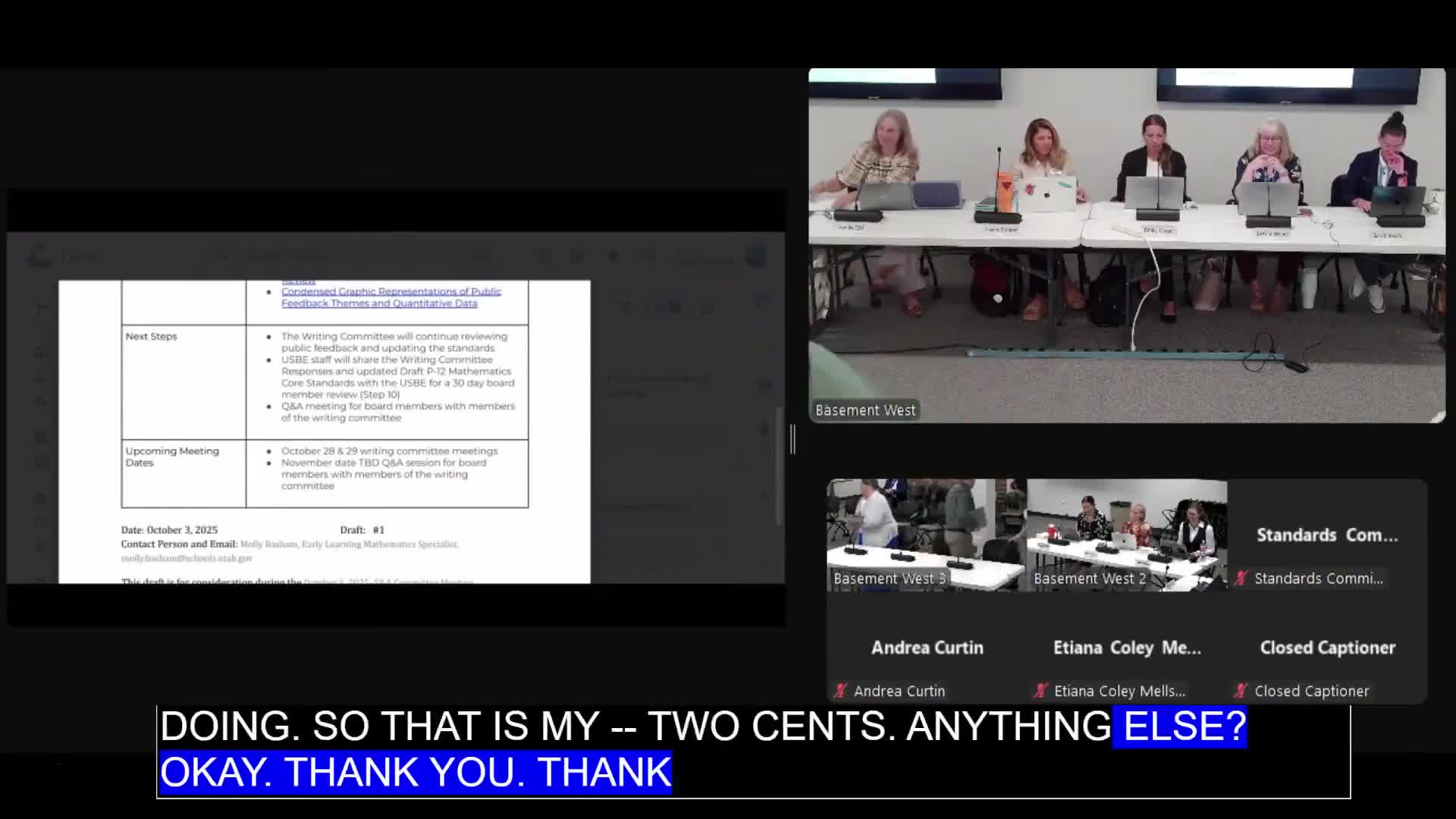Committee approves DLM alternate achievement science standards revision and forwards to board
October 04, 2025 | Financial Operations , Utah Board of Education, Offices, Departments, and Divisions, Organizations, Utah Executive Branch, Utah
This article was created by AI summarizing key points discussed. AI makes mistakes, so for full details and context, please refer to the video of the full meeting. Please report any errors so we can fix them. Report an error »

The Standards and Assessment Committee voted to approve the Dynamic Learning Maps (DLM) consortia revisions to the alternate achievement (essential elements) science standards and to forward them to the board for final approval.
Lia Voorhees, deputy superintendent of student achievement, described the state’s ongoing contract with the DLM consortia to develop alternate achievement standards and aligned assessments for students with the most significant cognitive disabilities, noting the work is intended to preserve alignment with core standards while reducing breadth, depth and complexity so instruction and assessment are accessible.
Committee members asked for clarity about which students take alternate assessments and how the consortium’s revisions will translate into instruction and measurable assessment items. Tracy Gulley, special education assessment specialist at USBE, said the crosswalk included in backup maps previously adopted essential elements to the updated set that will be instructed and assessed in the next operational cycle. Gulley said the updated set of essential elements will be in operation for assessment the following year.
Tanya Semerad, autism and significant cognitive disability specialist, and other staff explained that DLM provides four “access points” for each essential element, which function as a progression of entry levels so teachers can instruct and measure students at differing levels of complexity. Staff and several board members discussed one biology-related example (natural selection and trait distribution) to explore how mathematical reasoning and modeling might be taught and assessed for students in the alternate assessment population.
Why it matters: Under federal requirements, states may include alternate achievement standards and assessments for students with the most significant cognitive disabilities. Under the Elementary and Secondary Education Act (ESSA) states must limit alternate assessments to about 1% or fewer of the tested population; USBE staff noted that the rule and consortia process are designed to meet federal peer-review expectations.
Formal action: A committee member moved that the committee approve the DLM alternate achievement science standards revision and forward the revision to the board for final approval. The committee voted in favor; the chair noted the motion “passes unanimously.”
Staff follow-up: Committee members asked staff to provide example instructional resources and sample assessment items that illustrate how the updated essential elements and access-point progressions would be taught and measured for the alternate-assessment population. Staff said they would provide additional materials for committee review before the next board meeting.
Lia Voorhees, deputy superintendent of student achievement, described the state’s ongoing contract with the DLM consortia to develop alternate achievement standards and aligned assessments for students with the most significant cognitive disabilities, noting the work is intended to preserve alignment with core standards while reducing breadth, depth and complexity so instruction and assessment are accessible.
Committee members asked for clarity about which students take alternate assessments and how the consortium’s revisions will translate into instruction and measurable assessment items. Tracy Gulley, special education assessment specialist at USBE, said the crosswalk included in backup maps previously adopted essential elements to the updated set that will be instructed and assessed in the next operational cycle. Gulley said the updated set of essential elements will be in operation for assessment the following year.
Tanya Semerad, autism and significant cognitive disability specialist, and other staff explained that DLM provides four “access points” for each essential element, which function as a progression of entry levels so teachers can instruct and measure students at differing levels of complexity. Staff and several board members discussed one biology-related example (natural selection and trait distribution) to explore how mathematical reasoning and modeling might be taught and assessed for students in the alternate assessment population.
Why it matters: Under federal requirements, states may include alternate achievement standards and assessments for students with the most significant cognitive disabilities. Under the Elementary and Secondary Education Act (ESSA) states must limit alternate assessments to about 1% or fewer of the tested population; USBE staff noted that the rule and consortia process are designed to meet federal peer-review expectations.
Formal action: A committee member moved that the committee approve the DLM alternate achievement science standards revision and forward the revision to the board for final approval. The committee voted in favor; the chair noted the motion “passes unanimously.”
Staff follow-up: Committee members asked staff to provide example instructional resources and sample assessment items that illustrate how the updated essential elements and access-point progressions would be taught and measured for the alternate-assessment population. Staff said they would provide additional materials for committee review before the next board meeting.
View full meeting
This article is based on a recent meeting—watch the full video and explore the complete transcript for deeper insights into the discussion.
View full meeting

